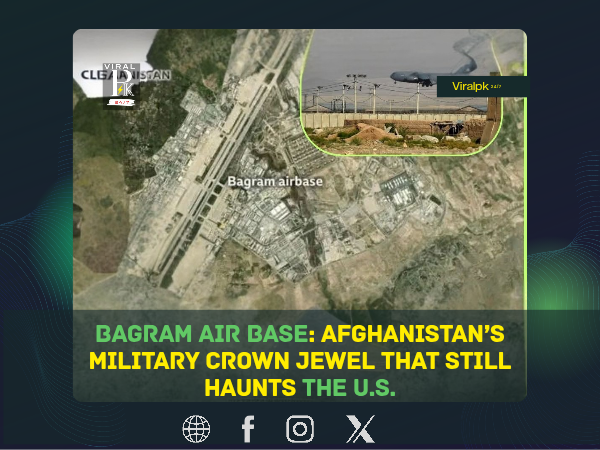By Viral PK 24/7 News Desk
Introduction
Hidden in the heart of Afghanistan near Kabul lies Bagram Air Base, once the largest and most strategically vital military installation in the region. Built by the Soviet Union in the 1980s and later transformed into America’s most formidable fortress after 2001, Bagram has witnessed the rise and fall of two superpowers. Its legacy continues to influence global geopolitics even after the U.S. withdrawal.
Soviet Origins
When the Soviet Union invaded Afghanistan in 1979, it understood that dominance on the ground required control of the skies.
- Construction: Spread across nearly 20 square kilometers (around 5,000 acres), Bagram featured two runways—one 3.5 km long capable of handling massive aircraft like the B-52 and C-5, and a shorter one for routine operations.
- Infrastructure Highlights:
- Huge ammunition and weapons depots
- Advanced workshops for aircraft and vehicles
- Afghanistan’s largest military hospital
- Drone and surveillance command centers
- Living quarters for over 20,000 troops
- Secret CIA detention cells
After the Soviet withdrawal, the base became a dormant giant, waiting for its next occupier.
U.S. Takeover and Expansion
Following the September 11, 2001 attacks, the U.S. military quickly seized Bagram.
- The Pentagon modernized the base with cutting-edge intelligence and communication systems, turning it into the central hub for drone operations and counterterrorism missions.
- Bagram served as the command headquarters for the entire U.S. operation in Afghanistan.
A Hub of Dark Secrets
Beyond its military might, Bagram gained notoriety for its secret CIA-run detention facilities, including the infamous “Black Jail,” where detainees allegedly endured harsh interrogations without due process. Many called it the “Guantanamo of the East.”
Strategic Significance
From Bagram, U.S. forces could observe and influence multiple critical regions: Iran, Pakistan, China, and Russia.
This geographic advantage made it a cornerstone of America’s strategy to project power across half of Asia.
Midnight Exit & Taliban Takeover
In July 2021, U.S. forces staged a sudden midnight withdrawal, leaving without informing Afghan authorities.
- Within hours, the Taliban seized the base, marking a symbolic collapse of U.S. influence.
- Reports suggest that sensitive intelligence equipment and military hardware were left behind, drawing global interest—including from China.
Why the U.S. Still Eyes Bagram
Even after a humiliating exit, American leaders—including Donald Trump—have expressed interest in regaining Bagram due to its unparalleled strategic value.
- The Taliban, however, have firmly rejected any U.S. return, sparking quiet tensions and a new chapter of geopolitical maneuvering.
Present-Day Bagram
Today, Bagram stands as a relic of two superpowers’ ambitions:
- A reminder of Soviet defeat,
- A testament to America’s failed occupation, and
- A potential flashpoint in a new era of great-power competition.
Conclusion
Bagram is more than a military airfield; it is a symbol of global power struggles. Whoever controls Bagram controls more than Afghanistan—they hold a key position in the balance of power across Asia.
📌 Disclaimer: This article is for informational purposes only and uses an AI-generated image for illustration. Follow VIRAL PK 24/7 for more updates.
SEO Keywords:
Bagram Air Base history, U.S. withdrawal Afghanistan 2021, Soviet Union Afghanistan war, CIA secret prisons Afghanistan, Taliban control Bagram, U.S. military bases in Asia, Afghanistan strategic military sites











